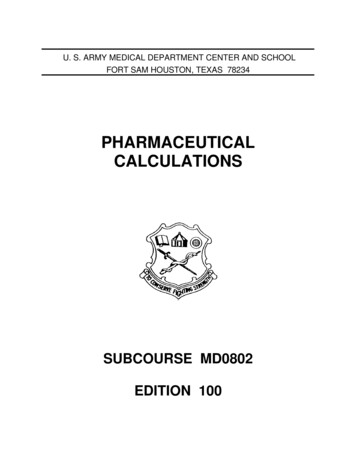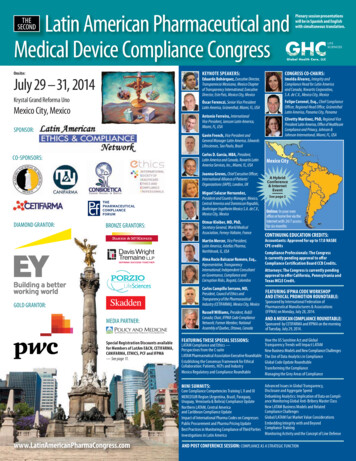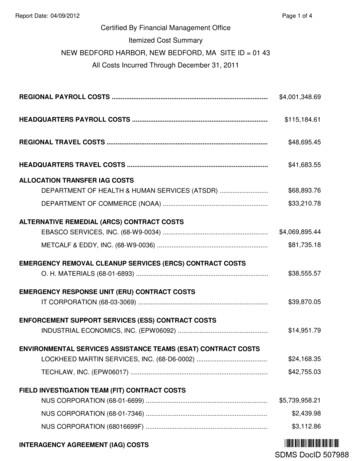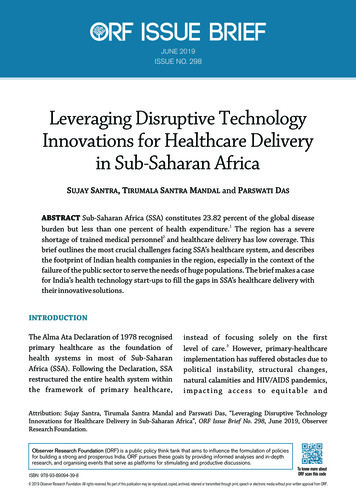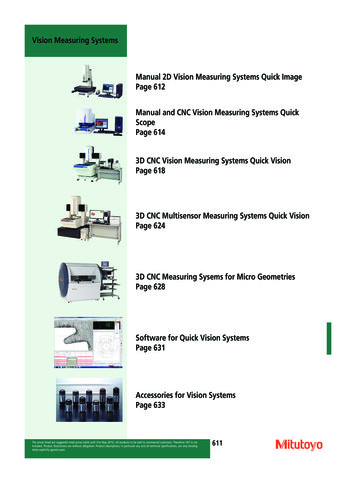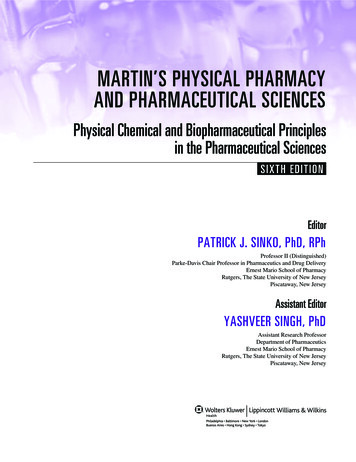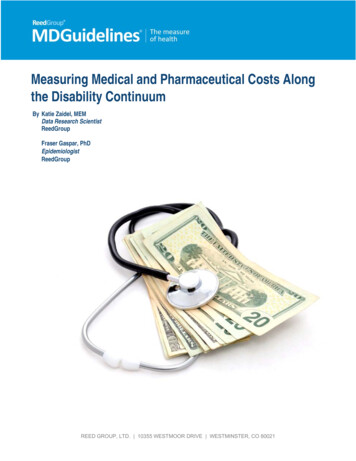
Transcription
Measuring Medical and Pharmaceutical Costs Alongthe Disability ContinuumBy Katie Zaidel, MEMData Research ScientistReedGroupFraser Gaspar, PhDEpidemiologistReedGroupREED GROUP, LTD. 10355 WESTMOOR DRIVE WESTMINSTER, CO 80021
CONTENTSAcronyms and Abbreviations . 2Executive Summary . 3Introduction . 4Study Data and Methods . 4Medical Costs and Diagnostic Groupings . 5Defining the Disability Episode . 6Disability Timeline for a Meniscus Disorder . 6Medical Costs Along the Disability Continuum . 8Treatment Determines Medical Cost . 8Average Daily Medical Costs . 9Accrual of Costs Over Time. 10Potentially Avoidable Costs. 11MDGuidelines Physiological Durations . 11Calculating Potentially Avoidable Costs . 11Conclusion . 14References . 15Acronyms and AbbreviationsACSAHRQCCAECCSCPT First Absence DateFull Duty DateHIPAAHPMIPWLassoMSAPACPhysiological durationsRTWSTDObserved durationAmerican Community SurveyU.S. Agency for Healthcare Research and QualityMarketScan Commercial Claims and Encounters research database from Truven Health AnalyticsClinical Classification SoftwareCurrent Procedural Terminology from the American Medical Associationfirst date of worker absence according to the short‐term disability claimreturn‐to‐work date according to the short‐term disability claimHealth Insurance Portability and Accountability ActHealth and Productivity Management research database from Truven Health Analyticsinverse probability weightingleast absolute shrinkage and selection operator methodmetropolitan statistical areapotentially avoidable costsevidence‐based return‐to‐activity duration recommendationsreturn‐to‐workshort‐term disabilitythe actual disability duration for the claimMeasuring Medical and Pharmaceutical Costs Along the Disability Continuum Page 2
EXECUTIVE SUMMARYReduced disability durations are beneficial for employers but are also associated with health benefits to thepatient (Talmage, Melhorn, & Hyman, n.d.). Typically, employers estimate the costs of disability-relatedabsences by multiplying the number of lost workdays by fixed estimates for lost wages, benefits, lostproductivity, and replacement labor. Missing from this equation is an estimate of the health care costs incurredduring these absences. In order to get a full and accurate picture of disability absence costs, we quantified: (1)the medical costs for each day during a disability episode, and (2) the potentially avoidable medical costs ifdisability cases returned to work at an optimal recovery duration.To estimate the cost of medical care during disability, ReedGroup analyzed a longitudinal dataset of 886kshort-term disability (STD) claims representing 41 million medical events. By evaluating the medical costsincurred during the disability episode and the length of disability as compared to MDGuidelines physiologicalduration tables, we calculated the potential medical cost savings associated with reduced disability durations.The level of detail available in this dataset allowed us to adjust for potential case-level covariates that affectedboth disability duration and medical costs, such as disease severity, treatment type, history of prior STDabsence, employment status, and more.We found that for non-surgical and surgical treatment of meniscus disorder, 35% and 50% of medical costs,respectively, occurred by the first absence date and 18-20% occurred after half of the employees returned towork (RTW). We observed significant variability in total medical costs for the disability episode by bothdiagnosis and treatment. For example, the average total medical costs during the disability episode for anxietyclaims was only 2k, while it was more than 26k for morbid obesity. With respect to treatment for meniscusdisorder, the average cost per case for non-surgical treatment was 3k, whereas arthroscopic meniscectomywas 7k, and total knee replacement was 25k.Although most medical costs are incurred at the start of an individual’s disability, we found that significantexpenses could have been saved throughout the disability episode. For example, among the 13,000 cases thatexperienced treatment for meniscus disorders, approximately 10.4 million in medical and pharmaceuticalcosts were incurred after the point when the individual could reasonably have been expected to return to work.Similarly, among the 1,256 carpal tunnel cases that had a carpal tunnel release surgery, approximately 957 inexcess costs per case could have been saved had the employees returned to work within the expecteddurations. When applied to a population of all U.S. workers with short-term disability benefits, we believe thatapproximately 6.5 billion, or 23% of total STD-related medical costs are avoidable. These results demonstratethat evidence-based medical care and case management, aimed at reducing disability durations, may helpemployers reduce medical expenditures.Measuring Medical and Pharmaceutical Costs Along the Disability Continuum Page 3
INTRODUCTIONDisability-related absences impose a staggering 443 billion on private employers in the U.S. due to absenceand lost productivity costs each year (IBI, 2017). This estimate, however, does not include the health care costburden that is incurred during the disability episode. Since private employers provide health insurance for morethan half of the U.S. population and half of all medical and pharmacy payments are attributable toapproximately one-quarter of employees who had a disability-related absence, medical costs must be includedin the estimates of disability-related absence costs (Gifford, 2017; Kaiser Family Foundation, 2016).Despite the burden of medical costs on employers, estimating the medical costs associated with disability hasproven difficult. Health Insurance Portability and Accountability Act of 1996 (HIPAA) regulations restrictemployers’ access to employees’ private health information to prevent this information from being used againstemployees in connection with their employment. The currently available medical cost estimates are typically asingle fixed estimate for all diagnoses and do not account for how medical costs decrease throughout thedisability episode.The goals of this project were to use a large, integrated set of health care and absence data to: (1) calculatethe daily average medical costs throughout the disability episode for multiple conditions; and (2) quantify themedical costs that could be avoided by reduced disability durations, after adjusting for case characteristics.STUDY DATA AND METHODSThe Truven MarketScan Health and Productivity Management (HPM) and Commercial Claims and Encounters(CCAE) databases were used for this study. These databases contain de-identified, patient-level disability(HPM) and medical (CCAE) claims for commercially-insured U.S. employees. Our analysis dataset includedemployees that had commercial health insurance and an STD absence that started between January 1, 2007and December 31, 2013. These short-term disability claims were connected to medical records that occurredbetween January 1, 2007 and December 31, 2014. Medical data from 2014 was included to capture the costsfor disability claims that began at the end of 2013. Since most STD programs do not provide benefits longerthan one year, we included cases with a disability duration between 0 and 365 (Bureau of Labor Statistics,2011; IBI, 2016). The final analysis dataset represented 886,110 STD claims for 7,614 diagnoses and includedmore than 41 million medical events (Figure 1).Measuring Medical and Pharmaceutical Costs Along the Disability Continuum Page 4
Figure 1. Linkage of key data elements from the Truven MarketScan Databases.MEDICAL COSTS AND DIAGNOSTIC GROUPINGSMedical costs from the CCAE database represent the total gross, eligible payment after applying pricingguidelines, such as fee schedules or discounts negotiated by health plans, but before the total payment wasallocated to the health plan or employee in the form of deductibles, copayments, and coordination of benefits.All medical events that occurred during the disability episode were used in our identification of treatments andcomorbid conditions, but we only counted the costs for medical events associated with the primary diagnosis.The diagnosis reported on the STD claim was used as the primary diagnosis for each record. Treatmentsand comorbid conditions were identified from the medical claims. To identify and categorize each medicalevent by relatedness to the primary STD diagnoses, we used a combination of the 2015 version of the Agencyfor Healthcare Research and Quality’s (AHRQ) Clinical Classification Software (CCS) and Major DiagnosticSubcategories as defined by the World Health Organization (Elixhauser, A; Steiner, C; Palmer, L, 2015).AHRQ developed the CCS to collapse diagnoses and procedures into a manageable number of clinicallymeaningful groups. The CCS single-level system groups diagnoses into 285 mutually exclusive categories. Wefound that the CCS system alone excluded some medical events that were relevant to the primary diagnosis,so we also included the costs for medical events for diagnoses in the same Major Diagnostic Subcategory asthe primary diagnosis.Measuring Medical and Pharmaceutical Costs Along the Disability Continuum Page 5
DEFINING THE DISABILITY EPISODEThe disability episode for each STD claim was defined using the employees’ first absence date and the datethey returned to full duty. Medical events and costs that occurred up to one week (seven days) prior to theemployees’ first absence date were included to capture medical events, such as pre-op office visits, imagingstudies, or procedures, that were directly related to the primary diagnosis. For some records, the benefit startdate was reported as the first absence date and these medical events occurred during a waiting period beforethe initiation of STD benefits. Medical events and costs that occurred up to one month (30 days) after the datethat the employee returned to full duty were included since medical costs do not end abruptly when someonereturns to work. This 30-day buffer served as an adjustment for the fact that cases with shorter durationstypically incurred higher medical costs in the month following the return to work date than did cases with longerdurations.DISABILITY TIMELINE FOR A MENISCUS DISORDERThe service date for each medical event was used to assign that event and its associated costs to the dayrelative to the first absence date, which was defined as day zero. Figure 2 illustrates a single disability episodefor a 50-year-old male with a meniscus tear who was absent for 64-days and incurred approximately 9,000 inmedical costs during that time.Figure 2. Example of a timeline of events and costs occurring during a single disability episode.Starting at the beginning of the timeline, we see that this man went to the emergency room three days beforehis first absence date, which cost 1,225. He then received an imaging study that cost 50 (Doppler scan) andan opiate prescription for 5. On the first day after his first absence date, he visited an outpatient physician( 215) and was prescribed an MRI ( 765). Again, he visited an outpatient physician ( 112) on day 8 and wasprescribed an MRI with contrast ( 1,640). He returned for an outpatient pre-operation visit ( 125) on day 11.On day 15, he had an arthroscopic meniscectomy surgery ( 3,055) and received a post-operative opiateprescription ( 5). He started physical therapy on day 18 and continued with this therapy every few days ( 65-Measuring Medical and Pharmaceutical Costs Along the Disability Continuum Page 6
76 per visit) until he returned to work on day 64. Since we included all events that occurred up to 30 daysafter the return to work date, we can see that the only other medical event for this man was an outpatient officevisit ( 90) on day 66, shortly after returning to work.For more information on meniscus disorders please review MDGuidelines for “Meniscus Disorders, Knee” and“Meniscectomy and Meniscus Repair” at www.mdguidelines.comMeasuring Medical and Pharmaceutical Costs Along the Disability Continuum Page 7
MEDICAL COSTS ALONG THE DISABILITY CONTINUUMTREATMENT DETERMINES MEDICAL COSTTo gain even greater granularity on the medical costs of a disability episode, we used the Current ProceduralTerminology (CPT) codes of a case to assign treatment groupings. For example, we grouped meniscusdisorder cases (ICD-9-CM codes: 836.0, 836.1, 836.2) based on whether or not the patient had any treatmentfor this condition and then whether or not the treated patients had surgery. We found a large variability in totalmedical costs by treatment for a meniscus disorder (Table 1). Average treatment costs ranged from 1,259 forthe group that did not receive treatment to more than 25k for the cases that had a total knee replacement.Arthroscopic meniscectomy was by far the most common treatment with 10,973 (71%) of meniscus disordercases in our analysis dataset receiving this option. No reported treatment related to the meniscus disorder wascommon but the 2,149 cases still incurred an average of 1,259 per case from office visits and diagnostictesting.Table 1. Summary of the distribution of costs for 15,488 meniscus disorder cases by treatment type.TreatmentCountSurgical TreatmentArthroscopic meniscectomy10,973Meniscus repair180Meniscus repair AND arthroscopic meniscectomy145Total Knee Replacement142Open AND arthroscopic meniscectomy6Open meniscectomy2Non-Surgical TreatmentNon-surgical treatment1,891No treatment2,149Total Medical Cost25th%ileMean75th%ile 4,085 5,938 5,738 8,565 5,729 8,982 7,409 11,695 11,721 25,538 6,841 14,373 8,588 14,939 14,039 36,482 7,943 19,764 649 47 3,831 1,259 4,739 993We repeated this evaluation for carpal tunnel syndrome to see if this variability exists for another commoncondition. Again, we found a large variability in total medical costs by treatment for carpal tunnel syndrome(Table 2). Average total medical costs for the surgical group was approximately twice the cost incurred by thenon-surgical treatment group. Our findings demonstrate that treatment is important for accurately estimatingthe total medical costs of the case.Table 2. Summary of the distribution of costs for 10,984 carpal tunnel syndrome cases by treatment type.TreatmentCarpal Tunnel ReleaseNon-Surgical TreatmentNo TreatmentCountSurgical Treatment1,261Non-Surgical Treatment8,828895Total Medical Cost25th%ileMean75th%ile 3,921 8,923 9,091 1,436 17 4,505 626 5,710 420Measuring Medical and Pharmaceutical Costs Along the Disability Continuum Page 8
AVERAGE DAILY MEDICAL COSTSOne primary goal for this research was to calculate the average daily medical costs during a disability episode.We found that the highest average daily medical cost was incurred on the first day of absence, followed by adecline in costs through the remainder of the disability, for both meniscus disorder and carpal tunnel syndromeand for all associated treatments. For meniscus disorder (Figure 3a), the average daily medical cost for thenon-surgical treatment option was higher than for arthroscopic meniscectomy from approximately 100 daysonward, indicating the ongoing need for medical treatment among the non-surgical group. The variability in theaverage daily medical costs was the greatest for the meniscus repair group because only 180 cases (1%)received this treatment. Both the variability and the small number of cases receiving this treatment indicate thatmeniscus repair is likely not a cost-effective treatment for meniscus disorder. Among carpal tunnel cases(Figure 3b), the cost declined faster through time for the surgical group than for the non-surgical group.Figure 3. Average daily medical cost for three meniscus disorder treatments(a) and two carpal tunnel treatments (b).Measuring Medical and Pharmaceutical Costs Along the Disability Continuum Page 9
ACCRUAL OF COSTS OVER TIMEWe evaluated the accrual pattern of medical costs throughout the disability episode and confirmed that asignificant proportion of medical costs were incurred on or before the first day of disability for both conditionsand all treatments (Figure 4). For meniscus disorder, 35% of costs for non-surgical cases and 50% of costsfor surgical treatment cases occurred in the early days of the disability (Figure 4a). For carpal tunnel syndrome, 40% of total costs were accrued by the first day of disability for both treatments. Despite these large upfrontcosts, we found that substantial costs continue to accrue throughout the remainder of a six-month disabilityperiod. Notably, these costs are incurred by fewer cases as time passes and cases return to work. When weidentified the point at which half of the cases have returned to work ( 50 days for both conditions), medicalservices that contributed approximately 18-26% of the costs, depending on the condition and treatment, hadnot yet occurred.Figure 4. Cumulative percent of total costs throughout a six-month disability period for meniscus disorders (a) and carpaltunnel syndrome (b).Measuring Medical and Pharmaceutical Costs Along the Disability Continuum Page 10
POTENTIALLY AVOIDABLE COSTSDue to the relationship between disability duration and medical costs, we quantified the medical costs thatcould be avoided if cases returned to work at the optimum recovery time. We used the MDGuidelinesphysiological durations as the optimum recovery time. Therefore, the potentially avoidable costs (PAC) are thedifference in costs if all employees returned at the optimum RTW date, as opposed to the observed RTW date.MDGUIDELINES PHYSIOLOGICAL DURATIONSThe physiological durations are recommended disability durations that represent the physiological healingtime for uncomplicated cases. Developed by the MDGuidelines Medical Advisory Board, the physiologicaldurations are based on clinical expertise and informed by real world claims. MDGuidelines physiologicaldurations provide minimum, optimum, and maximum recovery time by job classifications (Table 3). These jobclassifications were developed by the United States Department of Labor’s Dictionary of Occupational Titlesand are based on the amount of physical effort required to perform the work.For the purposes of this analysis, we used the optimum duration for the medium job class. For example, theoptimum duration for the medium job class in Table 3 is 21 (calendar) days.Table 3. Example physiological duration table.CALCULATING POTENTIALLY AVOIDABLE COSTSTo calculate potentially avoidable costs (PAC), we considered two important aspects of a leave:1. Due to the complexity of their disease, some cases may not have been able to return to work soonerthan their observed returned to work. Conversely, due to the lack of disease complexity, some casesshould have returned to work sooner than their observed return to work.2. Individuals returning to work more quickly than average may have more medical costs after they returnto work than individuals who return to work more slowly.To account for both of these aspects, we built marginal structure models where the outcome was all medicalcosts up to 30 days after RTW and used inverse probability weighting (IPW) to account for the probability thatinterventions could get a case back to work at the optimum duration.(Cole & Hernán, 2008)IPW’s were constructed by fitting a log-linear multiple variable regression model with disability durations as theoutcome. The following variables were potential predictors in the regression model: age, gender, history ofprevious disability leave, history of previous recurrence for same condition, insurance plan type, whether anopioid was prescribed, whether the employee is salaried or in a union, whether individual was hospitalizedMeasuring Medical and Pharmaceutical Costs Along the Disability Continuum Page 11
during leave, and whether a surgical procedure was performed. We used the sum of the number of uniqueICD-9-CM codes and the sum of the number of unique procedures codes as additional metrics of diseaseseverity. In addition, we generated geographical variables by linking each record’s metropolitan statistical area(MSA) or, if unavailable, county to data from the 2007-2011 American Community Survey (ACS) to get the fiveyear average values for median household income, population density (# of people per square mile), andpercent of residents with a college degree or more. This data was abstracted from the Census API with thefunction acs.fetch in the R statistical programming language.(Glenn, 2016) Coexisting conditions that fit withincomorbidity groupings as defined by Quan et al. (2005) were grouped (binomial, 0/1).(Quan, Sundararajan,Halfon, & Fong, 2005)To develop log-linear models to predict disability duration, we used the least absolute shrinkage and selectionoperator method (Lasso) with generalized linear model kernel.(Tibshirani, 1997) Using 10-fold cross validation,our Lasso method penalizes the mean squared error across a range of values for a regularization parameter(lambda). The final model and selected predictors were chosen using the largest value of lambda where theerror was one standard deviation below the minimum error across all lambdas. This procedure wasimplemented using the cv.glmnet function from the glmnet package.(Friedman, Hastie, & Tibshirani, 2010;Simon, Friedman, Hastie, & Tibshirani, 2011)The IPW weights are a ratio of the mean of the log disability durations (numerator) to the conditional densitiesof each case (denominator). The conditional densities are based on where the observed duration falls in anormal distribution with the mean equal to the mean log duration and the standard deviation equal to theresiduals of the standard deviation of the multiple variable regression mentioned above. Figure 5 demonstratesthe relationship between IPW and the difference between observed and predicted disability durations. Forexample, cases with an observed disability duration that was substantially higher than the predicted durationare given high weights. Similarly, cases with an observed disability duration substantially lower than thepredicted duration are also given high weights. Therefore, we are statistically enriching the analysis to targetthe cases where outside factors like case management, attitudes towards work, and other potentiallyintervenable characteristics may have impacted when someone returns to work.Figure 5. Example of the relationship between inverse probability weights (IPW) and the difference between observed andpredicted disability durations.Measuring Medical and Pharmaceutical Costs Along the Disability Continuum Page 12
We incorporated the IPW in another lasso model selection procedure, using the same methods above (theoutcome, the log total medical costs, and the predictors) and added disability duration. For each case aboveoptimum, we predicted the total medical costs using the optimum and observed disability duration. Thedifference between these two predicted medical costs is the PAC for that case. All PAC per condition weresummed for the total PAC and divided by the number of individuals with that condition to get the average PAC.We calculated the PAC for meniscus disorder and carpal tunnel syndrome by procedure (Table 4). Wecalculated the average PAC for the top conditions in the Truven HPM database (Table 5). Conditions with highfrequency and PACs (e.g., lumbar disc displacement) may be conditions where organizations should focustheir attention to reduce medical costs associated with disability claims.Table 4. PAC for meniscus disorder and carpal tunnel syndrome, by procedure.Total CostN(all cases)Meniscus DisorderNon-surgical Treatment1,734 900KArthroscopic Meniscectomy10,257 9.5 MMMeniscus Repair160 0 10.4 MMTotal PAC Savings 12,151Carpal TunnelNon-surgical Treatment8,719 2.4 MMCarpal Tunnel Release1,256 1.2 MM9,975 3.6 MMTotal PAC SavingsTreatmentAvg. Costper Case 529 928 0 868 277 957 361Table 5. PAC for the top diagnoses in the HPM Truven dataset.DiagnosisDepressive Disorder (311)Lumbago; low back pain (724.2)Anxiety (300.00)Lumbar Disc Displacement (722.10)Major Depressive Disorder, single (296.20)Uterine Leiomyoma, unspecified (218.9)Obesity, morbid (278.01)Inguinal Hernia, unilateral (550.90)Major Depressive Disorder, recurrent (296.33)Acute Bronchitis ,8967,4837,293Median(Optimum)43 (28)39 (14)40 (7)63 (32)57 (28)44 (28)31 (35)35 (25)68 (28)18 (5)25th %ile 338 491 279 2,259 513 6,742 15,740 3,450 785 434Mean 3,405 6,023 2,336 16,174 4,173 12,912 26,403 6,884 6,204 2,72175th %ile 2,775 4,406 1,762 17,682 4,256 16,217 30,409 8,504 7,003 2,308PAC/Case 830 1,573 851 3,250 1,168 1,927 770 135 1,874 409To calculate the PAC per year for all diagnoses across the 55 million U.S. workers with STD benefits, wemultiplied the STD claim rate for each diagnosis by the PAC per diagnosis and 55 million. When we summedthe PAC for all diagnoses, we found that STD programs could potentially save up to 6.5 billion per year byreturning cases to work within recommended time frames.Measuring Medical and Pharmaceutical Costs Along the Disability Continuum Page 13
CONCLUSIONWe found that medical costs change by day throughout a disability episode with the highest costs incurred atthe beginning of the absence and trending downward from there. We found that knowledge of both thediagnosis of the leave and the treatment of that diagnosis were important predictors of medical costs. Despitemost of the medical cost occurring at the beginning of a leave, substantial costs continue to accrue at laterstages of the disability absence, which presents an opportunity for case management to reduce both theduration of absence as well as medical costs. Our research highlights that medical costs are an important partof disability absence costs and employers need to include medical costs estimates in the evaluation ofdisability absences to better design medical and disability benefits that work together.Measuring Medical and Pharmaceutical Costs Along the Disability Continuum Page 14
REFERENCESBureau of Labor Statistics. (2011). Table 26 . Short-term disability plans : Duration of benefits , civilian workers, 1 National Compensation Survey , March 2011 Survey , March 2011 — Continued, 2011(March), 1–2.Cole, S. R., & Hernán, M. A. (2008). Constructing inverse probability weights for marginal structural models.American Journal of Epidemiology, 168(6), 656–664. http://doi.org/10.1093/aje/kwn164Elixhauser, A; Steiner, C; Palmer, L. (2015). Clinical Classifications Software (CCS). Retrieved ccs.jspFriedman, J., Hastie, T., & Tibshirani, R. (2010). Regularization Paths for Generalized Linear Models viaCoordinate Descent. Journal of Statistical Software, 33(1), 1–22.Gifford, B. (2017). Temporarily Disabled Workers Account For A Disproportionate Share Of Health CarePayments. Health Affairs, 36(2), 245–249. http://doi.org/10.1377/hlthaff.2016.1013Glenn, E. (2016). acs: Download, Manipulate, and Present American Community Survey and Decennial Datafrom the US Census. R Package Version 2.0.IBI. (2016). IBI Health and Productivity Benchmarking, Short-Term Disability Program, 2015 (Vol. 94105).Retrieved from https://ibiweb.org/tools/benchmarking/IBI. (2017). Illness Cost Estimator. Retrieved from iser Family Foundation. (2016). Employer Health Benefits, 174.Quan, H., Sundararajan, V., Halfon, P., & Fong, A. (2005). Coding algorithms
CCAE MarketScan Commercial Claims and Encounters research database from Truven Health Analytics CCS Clinical Classification Software . The Truven MarketScan Health and Productivity Management (HPM) and Commercial Claims and Encounters (CCAE) databases were used for this study. These databases contain de-identified, patient-level disability
